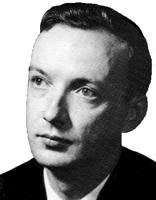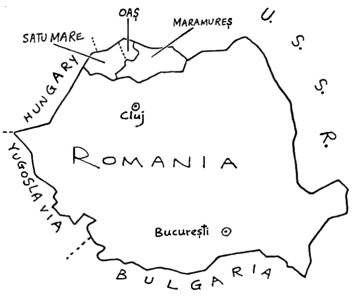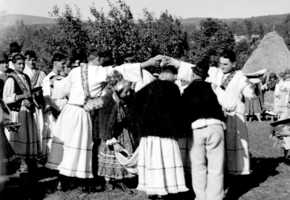
|
Folk Dance Federation of California, South, Inc.
|

|
CLICK AN IMAGE TO ENLARGE

Until 1968 the county (județ) of Maramureș in Northern Romania was equal in area to Los Angeles County, California. In that year it was officially divided into two counties, Satu Mare and Maramureș. The tiny district of Oaș, now administratively included in Satu Mare county, is usually lumped together with Maramureș by folklorists, due to the strong geographical and cultural similarities of the two areas.
Together they comprise a beautiful land, nestled in the valleys and on the forested slopes of the foothills of the Carpathian Mountains; their northern boundary meanders through those mountains and is Romania's national border with the Soviet Transcarpathian Ukraine.
The pre-industrial occupations of the people of Oaș and Maramureș were farming, livestock raising and lumbering. Industrialization has wrought many changes in the economy of the area, but traditional crafts still thrive: wooden architecture and carving remain fine arts here, folk textiles are still produced, and the local costumes are still made and worn (the heavy linen women's skirts and the men's wide trousers have gotten shorter with each generation, however!).
 The traditional folk dances are also vigorously alive, although they, too, are undergoing visible changes with each generation. As one visitor to Oaș in 1907 wrote, "...the people are renowned for their conservatism. They have not borrowed a single dance or song from anyone else – they have one circle dance, one couple dance, and one tune..." That comment is a naive generalization, but it has a kernel of truth as far as dancing is concerned. There really are only two categories of traditional dance in Oaș and Maramureș: a men's circle dance and a turning couple dance, both found throughout the area in many local forms and with a variety of names.
The traditional folk dances are also vigorously alive, although they, too, are undergoing visible changes with each generation. As one visitor to Oaș in 1907 wrote, "...the people are renowned for their conservatism. They have not borrowed a single dance or song from anyone else – they have one circle dance, one couple dance, and one tune..." That comment is a naive generalization, but it has a kernel of truth as far as dancing is concerned. There really are only two categories of traditional dance in Oaș and Maramureș: a men's circle dance and a turning couple dance, both found throughout the area in many local forms and with a variety of names.
The men’s dance is done in a closed circle around the musician(s), the men either joining hands or placing them on neighbors' shoulders; the movements involve tapping and stamping steps in place or gradually traveling counterclockwise, heel clicks, and syncopated hand clapping. The sequence of figures is not fixed; it is usually guided by an acknowledged good "leader." The local variants of this men's circle dance are known as bărbătescu ("men's dance"), bătrînescu ("old-timers' dance"), feciorescu ("young men's dance"), roata ("wheel"), de sărit ("jumping dance"), and others, sometimes called by several names in one and the same locale.
The couple dances of Oaș and Maramureș fall into the category of Romanian "turning" dances (învîrtite). The couples are in shoulder-waist position, clustered around the musician(s). They alternate steps in place with various turning and twirling figures. The men essentially do the same steps as they do in their local men's circle dance, and the women adjust their footwork to their partners'. Local names for the couple dance are învîtită, de-nvîrtit (both meaning "turning"), danț ("couple dance"), tropotită ("stamping dance"), and others.
Other pan-Romanian dance types (horă, sîrbă, alunelul, etc.) are rare in Oaș and Maramureș. Where they are found, they are in most cases considered as "imports." The same is true of such dances as the polka, "Seven Steps" and others that were introduced when the area was part of the Austro-Hungarian Empire. None of these dances are now current in the villages, although a simple kind of walking horă is done around the bride at weddings (hora miresei), and local amateur performing groups sometimes include adapted forms of the sîrbă, alunelul, etc. in their exhibitions to lend variety to the program.
The order in which the dances are done at an event is fixed by tradition. In the village of Ieud, Maramureș, for example, the four dances of the local repertoire are done in the following order: (1) bătrînescu (men's circle dance), (2) feciorescu (men's circle dance), (3) ardeleana (couple dance), (4) învîrtită (couple dance). Then the whole cycle is repeated from bătrînescu again.
Most dance figures in Oaș and Maramureș tend to be in 2-measure phrases (2/4 time), in a variety of rhythms. Particularly widespread are the so-called "dochmiac" rhythm patterns, phrases of 2 measures that cannot be separated because the step pattern is such that it overlaps the musical bar.
Music for dancing is provided by violin accompanied, in some places, by a guitar. The bagpipe is known to have been used in the area in former times, but it disappeared about 100 years ago.
Then, there are other types of "accompaniment" than musical instruments. Outsiders observing a dance in Oaș, for example, can hardly hear the instrumental melody because of the almost steady flow of yells, whistles and improvised chanted shouts emitted by the male participants. Chanted, rhymed verses (strigături) are common to Romanian dancing in general; in Oaș (where they are called țîpurituri, however, they are especially developed. In Oaș the țîpurituri are distinctive in that the men sing rather than merely scan them in rhythm, in a falsetto style with a melody related to that played by the musician. (Women also compose and sing these verses, but not during dancing.)
From the 1979 AMAN Institute syllabus.